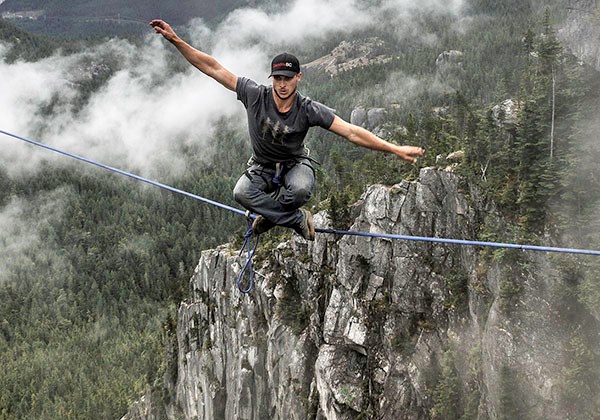On his second attempt, Spencer Seabrooke fell.
His legs wobbled and his arms flailed from left to right. He had reached the halfway point on a 100-foot long slackline strung between the 900-foot-high Stawamus Chief North Gully. There, as though suspended in mid-air, his chest hit the line as his legs wrapped around it.
Seabrooke held onto the line tightly and spun around it like a firefighter zipping down a fire pole turned on its side. Once on top again, Seabrooke regained his composure and casually shimmied his way back to the cliff’s edge.
After letting out a scream, Seabrooke did it all over again. This time he made the teetering crossing.
“I never force myself to go free solo,” the Vancouver-based highliner said. “If I do one and I think, ‘I could have done that without a harness,’ then I go for it.”
Highlining is a relatively new sport, so new that it doesn’t have its own Wikipedia listing. An offshoot of slacklining, the activity is not for the faint of heart. American free-climber Dean Potter has executed routes in Yosemite National Park that are 3,000 feet above the ground.
Seabrooke is one of a handful of Canadian highliners who takes it a step further: shedding his harness and completing the lines with no safety equipment other than his bare hands and steady feet.
His quest to follow in Potter’s footsteps recently generated an international buzz on social media. Two years ago, Potter free soloed a 33-metre route stretching across the Chief’s North Gully. Until last October, Potter remained the only person to do so.
Having free soloed The Original Line, Seabrooke was determined to be the second person to complete the crossing, Dean’s Line, named after Potter.
“It is really all about that first step,” he said. “As soon as you start walking, it becomes natural.”
Seabrooke focuses on the end point. He lets the high exposure melt away and then he gets down to the business of controlling his adrenaline. But once he’s on solid ground again, it all boils over.
“It is just like an explosion,” he said. “You are fighting that adrenaline the whole way across and then… It’s just the best natural high you can imagine.”
The video of Seabrooke’s free solo was picked up by slackline and media sites worldwide. Seabrooke chalks it up to the fall on his second attempt.
The sport isn’t as dangerous as it seems from the outside, Seabrooke said. One learns to minimize the risks, he said. He knows how to control his falls, noting even with a harness on, he doesn’t rely on the equipment.
Having picked up the sport two years ago, highlining has taken him to some of the world’s most beautiful places. Seabrooke is keeping his next conquest close to the vest. However, he promises it will be inspiring.
“Highlining is an art, it’s technical and it’s a sport,” Seabrooke said. “You have to trust in your abilities.”



